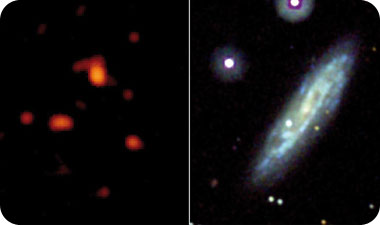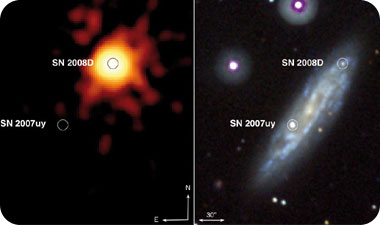A special observation records the first moments of a supernova explosion, caused when the iron core of a massive star fails to resist the pull of its own gravity
Michal Saaf, from the August 2008 issue

Massive stars end their lives in a dramatic explosion called a supernova. In the process of its existence, the star converts light elements into heavier elements in the process of nuclear fusion, and in this way energy is produced. However, as the elements become heavier, the amount of energy that can be extracted from them is small. Iron is the last element in this process, beyond which it is not possible to produce energy from nuclear fusion.
Light stars (less than eight solar masses) do not reach the iron stage at all, and end their lives in slow decay as compact bodies that keep getting cooler, containing relatively light elements, such as carbon and oxygen. These bodies are called white dwarfs.
More massive stars reach a state where their iron core cannot resist the pull of their own gravity. At this point, the star collapses under its own gravity, and the shock wave created by this collapse leads to an explosion in which radiation and matter are emitted, and additional elements, heavier than iron, are formed, which otherwise would hardly exist in our universe. This explosion has been known to science for years as a "supernova".
An unplanned observation

Now, for the first time, scientists were able to capture the moment of the birth of a supernova, and researchers from all over the world - including Prof. Eli Waxman and Dr. Avishai Gal-Yam from the Weizmann Institute of Science - mobilized for the work of observing and deciphering the data from the event. Supernova 2008D was discovered in January 2008 in the galaxy NGC 2770, which is 90 million light years away from Earth. NASA's Swift research satellite, which was being used at the time by researchers Alicia Soderberg and Ido Berger from Princeton University to observe another supernova in the same galaxy (SN 2007uy), picked up a sudden burst of X-rays.

X-ray (left) and ultraviolet (right) photograph of the galaxy NGC 2770. Taken during the observation of supernova SN 2007uy, during which supernova 2008D SN appeared. The images were taken in January 2008 by NASA's Swift research satellite.
Conclusions following the observation
In an article published in the journal Nature, the researchers say that according to the information gathered during the occurrence, it appears that the actual explosion process is quite similar to the process predicted by the theoretical models. The observation in the first hours of the supernova shows the characteristics of the exploding star: it is a compressed star, whose radius is about a million kilometers (not much larger than the Sun, although it is more massive than it), and a strong stellar wind emitted from it removed the remnants of the hydrogen shell that surrounded it.
It was also possible to conclude a lot about what happens in the first stages of the shock wave movement in the course star. In later stages, observations in a wide range of wavelengths were added to the initial discovery, which revealed various processes occurring in the material emitted in the explosion.
The dying stars, before their collapse, known as Wolf-Rayet stars, are a focus of interest due to the possibility that they are the causes of the mysterious phenomena of gamma radiation bursts, of unknown origin, that are sometimes observed throughout the universe. One of the explanations for the origin of gamma radiation bursts links them to supernova explosions.
The galaxy 0NGC 277 was observed during the occurrence of the supernova 2008D also using a gamma ray telescope (Swift Burst Alert Telescope), but no gamma ray burst related to the event was found, and the total energy emitted by the supernova explosion was only about a thousandth of that which characterizes gamma radiation bursts. This does not rule out the connection between supernovae and gamma radiation bursts, but it can be concluded that at least for some supernovae, which have certain characteristics, the connection does not exist.
This unique observation is also important for the future: from then on, supernova researchers knew that the first stage of the process must be sought through X-ray observations. It is hoped that this discovery will accelerate the study of supernovae in the coming years. In the first stages, the supernova should also produce strong gravitational waves and a large flux of neutrino particles - two phenomena that arouse great interest in the world of science, both in themselves and in the context of supernova research - and therefore there is great value in being able to detect their occurrence as early as possible in order to try and observe them.

8 תגובות
Ronan:
http://imagine.gsfc.nasa.gov/docs/ask_astro/answers/980424a.html
Correction of a slight error: this star is not slightly larger than our sun as written.
Our sun is much bigger and has a diameter of about 1.4 million km.
Hugin and Monin.. of Odin..
According to your answer it is possible to understand why you are not one of the editors here.
Point for thought.
Good Day.
Chai, sorry I'm not one of the editors here,, but if it's so hard for you to see... there are magnifying glasses and telescopes, and with a little bit of courage, and good will... find the links yourself and say thank you.
live,
This is the maximum resolution of the images uploaded to the site, so there is no point in increasing them further.
I have added the links to the images here as they were uploaded, but the improvement is not significant, if at all.
http://www.hayadan.org.il-content/uploads/space/supernova_after.jpg
http://www.hayadan.org.il-content/uploads/space/supernova_before.jpg
http://www.hayadan.org.il-content/uploads/space/supernova.jpg
Dear "Hidan" editors,
If you put pictures in the article, put them in a size where they can be seen clearly, or leave a link to open the picture in full size. There is no point in putting pictures as you put them, when you cannot see what they depict.
Good Day
For me personally, it is intriguing to understand the flow of neutron particles, in my mouth, emitted from the supernova..
Can any of the scholars here say how long such an explosion lasted?
minutes? days? Weeks ?
Because an atomic explosion (which is the most powerful we produce (perhaps actually after a hydrogen bomb))
Lasted for seconds, maybe a few minutes... How does this compare to an explosion like that that was there and from that the next question arises, how long could you actually see this explosion until it faded?